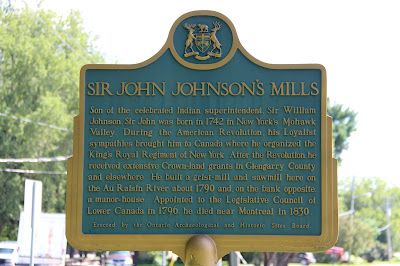Bethune-Thompson House occupies an area of land south of John Street and east of the Raisin River in Williamstown, Ontario.
BETHUNE-THOMPSON HOUSE
Built by Loyalist settler Peter Ferguson in 1784, the original log cabin on this site is one fo the oldest surviving buildings in Ontario. The cabin walls were constructed using a French Canadian technique called
poteaux sur sole where vertically placed, squared logs were held together by horizontal plates located along the top and bottom. The larger home adjoining it was built in 1804 by Reverend John Bethune (1751-1815), the first Presbyterian minister in Upper Canada. This home also incorporated a French Canadian construction technique,
columbage pierroté, which used a timber frame filled with masonry rubble. The fireplace overmantle installed by Bethune is one of the few remaining in the province. In 1815 David Thompson (1770-1857) acquired the house and lived here until about 1836. Thompson was an explorer and cartographer who surveyed much of what is now western Canada and mapped out the Canada-United States border. The house presents a unique architectural and historical record of early Ontario.
Ontario Heritage Trust, and agency of the Government of Ontario
MAISON BETHUNE-THOMPSON
Construite par le colon loyalist Peter Ferguson en 1784, la cabane en bois équarri initialement installée sur ce site est l'un des plus anciens bâtiments conservés en Ontario. Les parois de la cabane furent construites selon une technique canadienne-française appelée poteaux sur sole, où des troncs équarris placés à la verticale sont fixés dans des rondins horizontauz situés en haut et en bas. La maison plus grande accolée à la cabane fut construite en 1804 par le révérend John Bethune (1751-1815), le 1er ministre presbytérien de la province du Haut-Canada. La construction de cette maison incorpora, elle aussi, une technique de construction canadienne-française, le colombage pierroté, à savoir une charpente en bois comblée par une maçonnerie en pierre brutes. Le fronton de la cheminée, installé par Bethune, est l'un des rares examplaires encore visible dans la province. En 1815, David Thompston (1770-1857) acheta la maison et y vécut jusqu'aux alentours de 1836. Thompson était un explorateur et un cartographe qui arpenta une grande partie de ce qui correspond aujourd'hui à l'Ouest canadien et participa au tracé de la frontière canado-américaine. La maison constitue un important témoignage architectural et historique du passé de la province de l'Ontario.
Fiducie du patrimoine ontarien, un organisme du gouvernement de l'Ontario
 |
MAISON
BETHUNE - THOMPSON
HOUSE
circa 1804
A PROPERTY OF THE ONTARIO HERITAGE FOUNDATION
environ 1804
UNE PROPRIÉTÉ DE LA FONDATION DE PATRIMOINE ONTARIEN |
BETHUNE-THOMPSON HOUSE
Historic construction techniques and classic design are combined in this early Ontario home. The vertical log south wing may date from the 1780s when Loyalist Peter Ferguson settled on the site. The central part was build ca. 1805 as a manse for Rev. John Bethune, the first Presbyterian Minister of Upper Canada and was later the residence of explorer David Thompson. Beneath the studdo of the main block, the timber frame has three walls infilled with rubble stone and a fourth with "stick and mud." The five-bay facase, formerly flanked by similar wings, expresses the British classical tradition.
Historic Sites and Monuments Board of Canada
Government of Canada
MAISON BETHUNE-THOMPSTON
Cette maison allie à une composition classique les techniques de construction de jadis. L'aile sud, en poteaux sur sole, aurait été construite dans les années 1780, par le loyaliste Peter Ferguson. Bâtie vers 1805 pour John Bethune, le premier pasteru presbytérien du Haut-Canada, la partie centrale de la maision, en bois de charpente recouvert de crépi, comporte trois murs remplis de moellons bruts et un quatrième, de torchis. La maison fut également occupée par l'explorateur David Thompston. La façade à cinq baies, autrefois flanquée d'ailes symétriques, reflète la tradition classique britannique.
Commission des lieux et monuments historiques du Canada.
Gouvernement du Canada
"The property on which the Bethune-Thompson House is located was originally granted to Peter Ferguson in 1784, a Scottish immigrant to the American Colonies who served in the King's Royal Regiment of New York. As a Loyalist settler to Charlottenburgh Township he settled on the west half of Lot 50, Concession 1 and built a log house. In 1804.
"Loyalist settler Reverend John Bethune (1751-1815) purchased the land from Ferguson and built a house, to which he later moved and attached the Ferguson log cabin to form a side wing of his house. Bethune was founder of St. Andrew's Presbyterian Church in Williamstown and was the first Presbyterian minister in Upper Canada. He also founded congregations and preached at Cornwall, Lancaster, and Martintown. In 1815, just weeks after the death of Rev. Bethune, his wife Véronique (Wadden) Bethune, sold the house to David Thompson (1770-1857). Thompson, a retired North West Company partner mapped much of western Canada. He also worked for the Boundary Commission, mapping out the border between British North America and the United States. The Thompson family lived in the home from 1815 to about 1836, when the family incurred financial difficulties and left for Montreal.
"The property was sold to Farquar McLennan and his descendants lived in the house until 1937. In 1937, William Smart, the McLennan's farm manager, purchased the home and Mae Smart (daughter-in-law to William) sold the property to the Ontario Heritage Trust in 1977 to ensure the preservation of the property. The house underwent a major restoration in the mid 1980s.
"Archaeological excavations were conducted at Bethune-Thompson House in 1980, 1981 and 1993 and uncovered more then 36,000 artifacts. A number of mixing bowls, a pharmaceutical jar which dates from 1730-1830, a plate rim with a feather-edge decorative motif, attributed to the Wedgwood Factory, were all some of the items found on the property."
(From
Statement of Significance, Canada's Historic Places.)
Bethune-Thompson House received recognition as a
National Historic Site of Canada by the Government of Canada on October 10, 1966 and recognition as an Ontario Foundation Property by the Ontario Heritage Trust on June 6, 1977.





































































